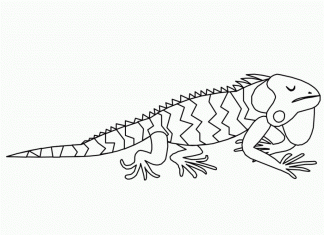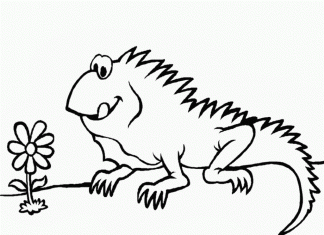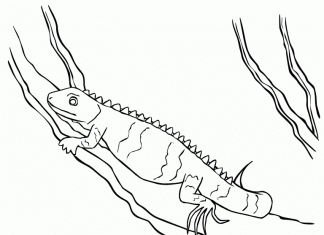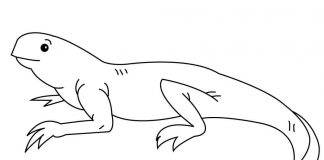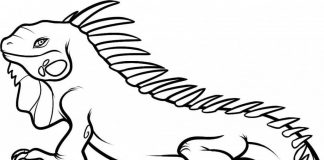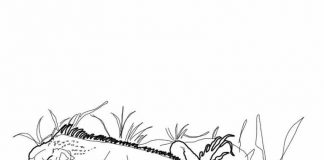Iguana is a genus of lizards in the iguana family (Iguanidae), including a variety of species found mainly in tropical and subtropical regions.
Iguana Coloring Pages
information
- Appearance and size: Iguanas are characterized by their long body, tail and distinctive elongated snout. Depending on the species, they can range in color from green to brown. Some species reach impressive sizes, reaching up to several feet in length.
- Ecology: Iguanas typically live in rainforests, savannas, coniferous forests and rocky areas. They are often found in areas with abundant vegetation, which provides them with a source of food and shelter.
- Feed: Iguanas are herbivores. Their diet consists mainly of leaves, fruits, flowers and young shoots. They have special adaptations in their digestive system, such as specially adapted intestines that help them digest difficult-to-digest plant materials.
- Thermoregulatory behavior: Iguanas are variably warm animals, which means that their body reaches ambient temperatures. As such, they need access to adequate sunlight to warm up or, conversely, hide in the shade to cool down.
- Variable colors: Many iguana species have the ability to change their skin color. This allows them to regulate their body temperature and is used to communicate with other iguanas.
- Marine iguanas: There is also a group of iguanas known as marine iguanas, which have an aquatic lifestyle. They inhabit coastal areas and use marine vegetation as a food source.
- Protection of species: Some iguana species are threatened with extinction due to habitat loss and poaching. Conservation measures are being taken to preserve their populations.
- Cultural significance: In some regions, iguanas have long been used as a source of food or material for making traditional musical instruments.
- Domestic animals: Due to their exotic appearance, some species of iguanas are sometimes kept as pets. However, as pets, they require proper care, a proper diet and an environment close to their natural habitat.
- Green iguana: One of the best-known iguana species is the green iguana (Iguana iguana), which is found in Central and South America. It is a large, colorful and distinctive lizard.
trivia
- Tail regeneration: Iguanas have the ability to autotomize, or discard parts of their body when threatened. When an iguana is attacked and grabbed by its tail, it can detach it from its body, giving it a chance to escape. The discarded tail can later grow back, although the new tail may be shorter and less colorful.
- Long digestive tract: Iguanas have a relatively long digestive tract that is adapted to digesting difficult-to-digest plant materials. The long digestive tract allows for more thorough absorption of nutrients from a plant-based diet.
- Life expectancy: Some iguana species can live quite long in captivity. The green iguana, for example, can live from 15 to as long as 20 years or more, subject to proper care and conditions.
- Visual communication: Iguanas use their eyes to communicate. Opening and closing their eyelids can be used to convey information to other iguanas, indicating their emotional state or readiness to interact.
- Variable skin color: As mentioned earlier, iguanas can change the color of their skin depending on their mood, temperature and other factors. This phenomenon is particularly evident in young iguanas.
- Relationships with water: Some iguana species, such as the marine iguana, have a semi-aquatic lifestyle, living in coastal areas and spending a lot of time in the water. They have elongated tails that help them move through the water.
- Iguanas vs incubation: Female iguanas often lay their eggs in the ground and then wait for the eggs to hatch. Even so, the ambient temperature can affect the sex of the offspring. Higher temperatures often lead to the birth of males, while lower temperatures favor the birth of females.
- Abrasive teeth: Iguanas have teeth that constantly wear down in the process of chewing their food. This keeps their teeth sharp and makes it easier for them to digest a plant-based diet.
- Impact on the ecosystem: Iguanas play an important role in the ecosystem by feeding on vegetation. However, in places where iguana populations are excessive, they can affect changes in vegetation and the ecosystem.
- Protection and threats: Some species of iguanas are threatened with extinction, mainly due to habitat destruction and trade in their skin or as pets. That's why conservation organizations are taking steps to protect these fascinating creatures.

